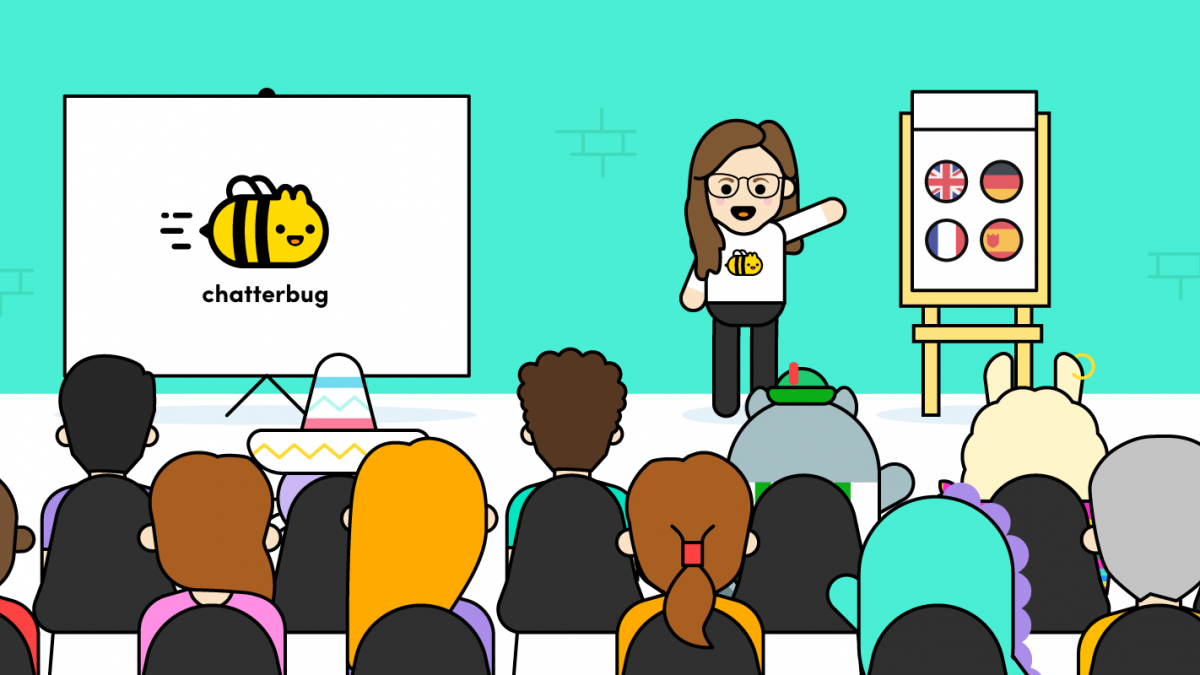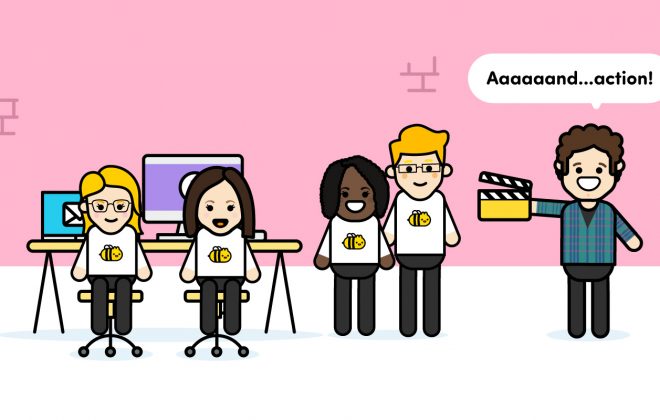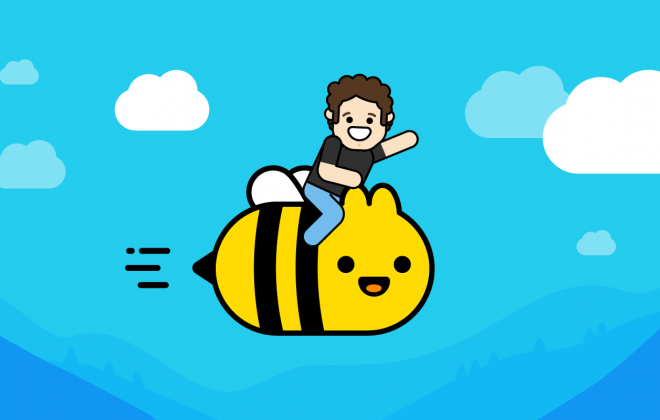Language Learning in 2030. Game Over for Humans?
My name is Inda. I’m a language educator and a passionate language learner. I have been learning languages since… well I can’t remember the last time I wasn’t learning a language. I have taught German, English, and Spanish as foreign languages in traditional schools, language schools, and online schools and I have seen, again and again, the problem of trying to artificially constrain the pace of an entire group. A little over 2 years ago, because of a student, I entered a field I would never have considered as a trained teacher: software development. I now work for a language learning platform called Chatterbug, based in Berlin and San Francisco.
At Chatterbug, I lead our curriculum team, made up of linguists and educators, and work in close collaboration with our engineering team. Working in this melting pot of linguists, coders and teachers is a fantastic experience, because what we usually discover in those meetings is that our engineers don’t know what tools we need to teach better, and our curriculum team doesn’t yet know what tools are even possible to make our job easier. Remember when Henry Ford said: if I had asked people what they wanted, they would have said “faster horses”. So me and my team were always telling our engineers “gives us faster horses”, and they were like “well, there is other thing we could try, it is called a car…” So we came up with this system of making feature requests: we as educators describe our problem, and what we want to achieve in pedagogical terms, and they are able to design a tool that solves our problem. I am going to tell you about what I have learned about the potential of technology in education while working at Chatterbug.
Let me start by asking you a question:
How much of what you learned for school tests can you still remember?
The Status Quo
The school systems most of us grew up with group students together, usually by age, sometimes by ability, and the aim of the teacher is to maintain the same pace for the whole group. So what usually happens in language classrooms is that the teacher gives a lecture, we practice, we go home and we do some homework. The next class, we do more of the same. After a few weeks, we write a test. But what is the grade for? What are we testing? Is it a matter of who the better student is? Is it to motivate students? Are tests supposed to be the students’ objectives?

This is what really happens: on a test, maybe I get 75 percent, maybe you get 90 percent, and someone else gets 95 percent. Even though the test identified gaps in our knowledge – I didn’t know 25 percent of the material – the whole class will then move on to the next, more advanced topic that’s going to build on those gaps. Curriculum developers plan their curriculum assuming students will have mastered the material before they move on. No wonder studies confirm that students who struggle with something now will typically continue to struggle with related topics in the future!
Sam Khan, creator of Khan Academy (a platform that provides free educational content) has this great analogy, which shows just how absurd this is. Imagine if we did other things in our life the way we teach now in schools.
Take building a home for example. Imagine we bring in the contractor and say:
“We have two weeks to build the foundations of the house. Do your best”.
So they do what they can. Maybe it rains. Maybe some of the supplies don’t show up. And two weeks later, the inspector comes, looks around, and the conversation goes something like this:
“OK, the concrete is still wet right over there, that part is not quite up to code… I’ll give it 80 percent.”
“Great! That’s a C. Let’s build that first floor!”
Same thing happens for the first floor too. Two weeks for the contractors to do what they can. The inspector then shows up and gives it 75 percent. Good job. Keep going and do the second and third floors and all of a sudden, while working on the third floor, the whole structure collapses.
Going back to education, people might say it was a bad contractor, or maybe we needed better or more frequent inspections?
The Problem With Tests
I think standardized tests have a place. The problem with tests in education is that instead of being there to measure objectives and meet educational standards, they are used as a tool to accomplish learning. And scores or grades are punishments or rewards. Mistakes are never framed as missing pieces on the way to mastery, but rather as a failure. Tests with poor design strategies aren’t even good at reflecting competences. Can we really assume that students who score high in math are good at processing information and reasoning abstractly? According to research, high standardized scores have little correlation with memory, attention and processing speed. High test scores often simply mean a student excels memorization and multiple choice test taking.
So what’s the alternative? For most of my career, I’ve been trying to find an alternative.
The Future of Language Education
Before I tell you more about Chatterbug, I would like to come to my actual question.
‘Language teaching in 2030: Is it going to be game over for humans?’.
I think this is an important question to ask because there’s never been more potential and opportunity than now to be innovating in language learning, and to be thinking about which parts of the current classroom model will survive, and which will fade into history over the next decade. In large part, this is due to the ten years of non-stop science-fiction-come-true we’ve enjoyed, from AI in Silicon Valley that can beat the best human players of Go! all the way to [AI news anchors](http://time.com/5450141/china-xinhua-artificial-intelligence-news-anchor/) that are hard to tell apart from real people.
Xinhua’s first English #AI anchor makes debut at the World Internet Conference that opens in Wuzhen, China Wednesday pic.twitter.com/HOkWnnfHdW
— China Xinhua News (@XHNews) November 7, 2018
Arthur Clark, a British sci-fi writer once said “Any teacher who can be replaced by a machine should be.” Seeing the video above, you start questioning the position of the teacher altogether. This observation continues to be much-repeated, especially in debates concerning the ongoing digitization of education. But what human beings are really good at – as opposed to machines – is creating social connections, thinking critically, bonding, feeling empathy, communicating. Unfortunately, teachers can’t make good use of this because they are too busy handing out and correcting tests, too busy delivering information in front of the classroom, too busy trying to constrain the pace of each student to match the group.
Evolving Content Delivery Channels
It’s just a matter of time until lectures delivered in person are replaced by videos. It seems unlikely, given the benefits of videos (such as transcriptions, and the ability to replay, rewind and pause), that teachers standing at the front of a classroom will be the preferred mode of delivering content even 10 years from now. You already see this transition taking place with the rising popularity of video-only online educational platforms such as Khan Academy or Udemy and the popularity of video-recorded courses from traditional universities, such as Stanford and Cambridge.
Vocabulary tests, long considered a staple of every language class, are being taken over by software. Instead of identical tests for everybody, these applications are already able to make predictions about when a student is going to forget a word, and optimize their revision schedule for each individual based on past performance.
Most importantly, I would argue that we can reduce teachers’ workload if we understand that they can no longer be in control of the student’s learning journey now that information is at everyone’s fingertips. Instead, we need intelligent systems to adapt and personalize the journey according to the student’s needs, pace and overall goals and interests.
Separating the Wheat From the Chaff
Research skills are now more important than ever. This makes me wonder why our academic systems keep delivering so much information in the era of Google, YouTube and Wikipedia, instead of teaching our students to distinguish reliable sources from unreliable ones, instead of teaching them how to research, innovate, and creatively approach problem-solving tasks?
Internet services and artificial intelligence are creating a wealth of opportunities resulting in personalized learning no longer being a utopian concept because the ingredients to do it well are increasingly readily available to us all. This is the reason I’m so excited to be working in this space at this moment in time.
Learning From the Past
I would now like to revisit the educational philosophy that was proposed back in the late 1960s by Benjamin Bloom: Mastery Learning. The idea of learning to mastery is to make sure students reach a high level of understanding and are able to apply their learning in different contexts. In order to achieve this, we need to be flexible in everything except the outcome – achieving mastery. The when and how long are variables that will always vary from student to student.

This model has been one of the most studied methods over the past 50 years. Students of science, probability, and social studies yielded especially consistent and positive results, and yet, despite the growing body of empirical evidence in its favour, many mastery programs in schools have since been replaced by more traditional forms of instruction.
Fair enough, back in the 60s or even 15 years ago, mastery programs where every student follows their own course of learning required a high, almost unrealistic level of commitment and flexibility from the teacher to manage the classroom.
This is where the flipped classroom method comes in. We turn classrooms into places to practice and to apply, instead of a place to attend lectures. A flipped classroom reverses the traditional learning environment by delivering instructional content, often online, outside of the classroom. It moves hands-on activities into the classroom. And this is what inspired us at Chatterbug.
Chatterbug
At Chatterbug, the power of our product is that with a combination of engineering resources and language experts, we have managed to entirely flip the classroom. Everybody on the team is using our product, on the path to learning their second, third or in some cases, seventh language, and we are all contributing to create better tools to learn.
And it’s quite simple.
We are best known for our online live lessons. Students practice with a native speaker in different scenarios such as ordering food or a mock job interview. We invest a huge amount of research and development time into creating the content to guide students through these conversational lessons. This is not only because we believe that speaking is essential, but also because speaking can be the scariest aspect of a language learning journey. So we provide content to spark meaningful interactions between students and tutors and we believe our tutors form the pillar of our students’ experience, because after all, who would want to learn a language to speak with a machine?

The other part of the system aims to teach you vocabulary with our self-study tools. This is the outside of the classroom part of the system. We use spaced repetition to ensure you won’t forget the words you want to learn. You learn to achieve mastery, not to pass tests (in fact, we don’t do tests!) using the algorithms I mentioned before to schedule your revision plans.
To learn grammar, we introduce the rules in simple and friendly language followed by targeted exercises. We leave it up to you if you want to read the explanation of the rule, as we know some people learn grammar best by deduction. Our grammar exercises use a system of randomized quiz questions, which intelligently adapts to student responses, so that they see a different set of questions with each attempt until they master a certain grammar topic.
The advantage of learning in your own time is not only the increased flexibility – more aligned with our busy modern schedules – but also that it has the nice side-effect that it allows you to pick the times when you are most productive, most concentrated or most motivated to learn. I recently discovered I perform best at my French lessons in the late morning, so I try not to schedule classes in the afternoon anymore. After 6pm I’m not particularly focused and I bored my poor tutor to death.
Choosing the right time to learn can have a great impact on your progress! Me and my French tutor in a morning lesson (left) and a late afternoon lesson (right).
Me and my French tutor in a morning lesson (left) and a late afternoon lesson (right).
The Chatterbug Movement
By using Chatterbug, you are exposed to new content as you progress through our curriculum, and this happens naturally and incrementally depending on your own progress. Our curriculum follows the CEFR standards.
The most important thing is that the lesson time is reserved for practicing and consolidating the material you have learned. This way, class activities are more engaging, more fun, and ultimately, more productive.
We built Chatterbug like this because we believe this is how learning should be. We envision a system that is flexible, intelligent and entirely personalized to your learning style. But there’s still a lot of work to be done!
I believe Chatterbug is part of a movement that aims to achieve a world where technology does what tech does best: provide flexible, intelligent, self-paced systems to challenge every student in the right time, and the right amount outside the classrooms.
Teachers are still there, doing what they do best: having meaningful interactions with their students, providing feedback and guidance on metacognition skills (“learning to learn”), coordinating peer-tutoring and collaborative learning projects, mentoring oral language interventions, and teaching very important career skills like time management, leadership and communication skills such as assertiveness, so important in our daily work-life.
I believe our education system should and will go in the direction of increased collaboration between education experts and technologists. It’s clear that systems built by one or the other group alone, do not provide engaging or effective solutions.
To revolutionize education, we should increase efforts to use machines to humanize the classroom. If we manage to flip classrooms in schools, teachers will always have plenty to do. If not, their jobs will probably become more and more dispensable or what is even worse, teachers will increasingly be burdened with work that could be automated.
I am not arguing that by incorporating a great deal of intelligent tools, education should become a mechanical system; it is about people. We can all remember a handful of teachers that inspired, mentored, stimulated, provoked or otherwise connected us with their subjects. Some of us even ended up picking careers purely because of these experiences. This is what education is about.
Technology is here to take care of the work it can do better, and not because we want to ultimately replace teachers, as Arthur C. Clarke envisioned. Tech frees up teachers to have more of the student-teacher interactions that humans do uniquely well: the conversations that spark lifelong passions.



